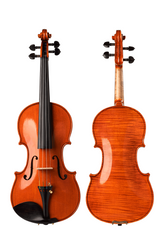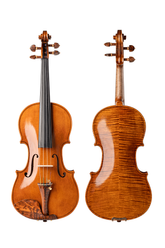How to Maintain and Care for Your Violin
A well-maintained violin can last over three centuries, and with proper care, its longevity may extend even further. However, in reality, many violins face a shorter lifespan due to war, accidents, pest infestations, or frequent use.
Typically, a violin can serve five to six generations of professional musicians. Over time, the wood gradually ages, and the strength of the violin's top plate diminishes. When the plate can no longer withstand the tension of the strings, structural deformations occur, directly impacting sound quality. At this point, the violin may no longer be playable.
Precautions for Daily Use of Violins
As a delicate and valuable instrument, violins demand careful handling in daily use. While one might rarely drop a violin, it is surprisingly easy to damage it unintentionally. For example, placing a violin casually on a chair, sofa, or bed during conversations, or hanging it on a music stand during breaks, can lead to accidents. Avoiding such risky behaviors can significantly reduce the chance of damage.
Effects of Temperature and Humidity
Temperature and humidity fluctuations can severely harm a violin. To protect it, consider the following:
- Avoid exposing the violin to direct sunlight or heat sources;
- Keep it away from radiators or humidifiers;
- Prevent sudden changes in humidity levels.
When traveling by air, always carry your violin in the cabin rather than placing it in the luggage hold. The luggage area, being close to the aircraft's power system, tends to have high temperatures, which could cause the glue in the violin to weaken or even collapse.
Handling Damage and Repairs
Temperature and humidity variations may cause the violin's top plate to detach from the ribs, resulting in loose, unfocused sound or additional noise. To identify such issues, gently tap along the edges of the violin; any gaps will produce a distinct sound. If you detect a problem, loosen the strings immediately and seek professional repairs as soon as possible.
If a piece of wood chips off due to impact, save the fragment and have it professionally reattached. During the performance, avoid letting the frog of the bow strike the violin's edges or corners. Similarly, when practicing pizzicato, ensure that your fingernails do not scrape the top plate. Always hold the violin by the neck, avoiding direct contact with the body, as sweat from your hands contains acids that can gradually damage the varnish.
Daily Maintenance Tips
After playing the violin, follow these steps before storing it in its case:
- Tune Down the Strings: Lower the pitch of the strings by one or two semitones to reduce tension on the violin.
- Clean the Violin: Use a soft cloth to wipe the instrument thoroughly, paying special attention to the neck, pegbox, fingerboard, and strings. Also, remove rosin dust from the top plate and strings.
These simple cleaning habits take less than a minute but can significantly preserve the violin's appearance and extend its lifespan. Persistent hand sweat may lead to the lowering of the fingerboard over time. Moreover, it can seep into gut strings, causing the core to elongate and the metal winding to unravel, rendering the string unusable.
Follow Fiddlover Violin Shop to learn more about violins.





